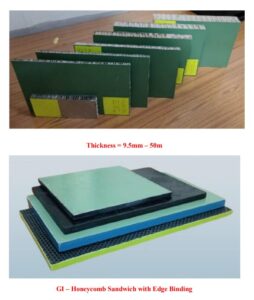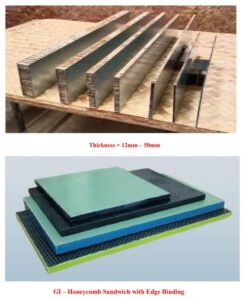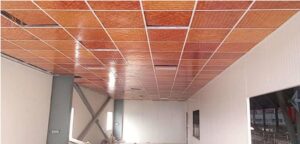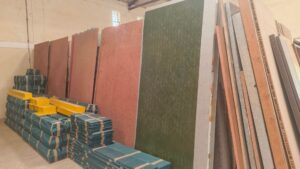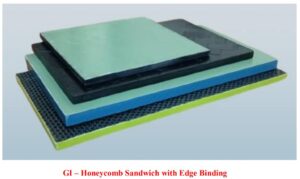In an era where sustainability meets performance, architects, designers, and builders are exploring new materials that deliver both environmental benefits and high functionality. One standout innovation in the roofing world is the bamboo composite roofing sheet, engineered from bamboo mat laminates and resin-based composites. This material is redefining the way we design and specify roofs for modern construction.
What Are Bamboo Composite Roofing Sheets?
Bamboo composite roofing sheets are manufactured by layering woven bamboo mats, impregnating them with high-performance polymeric or phenolic resins, then hot-pressing them to form a robust panel or corrugated sheet suitable for roofing applications. This technology was originally developed to produce panels with enhanced mechanical, thermal and durability properties when compared to conventional roofing sheets. A version described in technical literature features a trapezoidal sheet approx. 2,466 mm × 1,220 mm with ~4.5 mm thickness and density of up to ~965 kg/m³.
In addition, there is clear mention of “Bamboo composite roofing sheet – Top surface with waterproof glass fibre lamination and bottom natural bamboo with PU coating/decorative lamination” in a product summary list.
Key Properties and Specifications
Here are some of the key properties that make bamboo composite roofing sheets a compelling choice for sustainable roofing:
High density and strength: As an example, one data sheet indicates density around ~965 kg/m³ and a weight of ~15.8-16.5 kg for the sheet size mentioned.
Water absorption & moisture resistance: According to standards for bamboo mat corrugated sheets (BMCS) the water absorption may be as low as ~8.25% and the material is boil-water proof.
Load-bearing capacity comparable to metal or asbestos-cement sheets: For example in one specification the load bearing capacity in dry state noted ~5.65 N/mm² for a 3.5–4.0 mm BMCS variant.
Thermal and acoustic insulation: The material exhibits lower thermal conductivity compared to certain metal or cement sheets, improving indoor comfort.
Termite, fungus, corrosion resistance: Because the bamboo mats are resin-impregnated and composite-processed, these sheets perform better than untreated timber or standard panels.
Sustainable raw material base: Bamboo grows rapidly (harvestable in 3-5 years) and offers high renewability compared to slow-growing hardwood or energy-intensive materials.
Design adaptability: Available in various sheet sizes, shapes (corrugated, trapezoidal), and with finishes such as UV-coatings, PU coatings, or decorative laminations for aesthetic appeal.
Applications in Roofing and Construction
Residential roofing: Ideal for eco-homes or green buildings where lightweight, renewable roofing is preferred.
Commercial/industrial sheds: The strength and durability make them suitable for large span roofs or semi-industrial buildings.
Refuge/temporary shelters & community structures: Given their ease of installation, light weight, and resilience, they are used for camps, disaster-relief housing and modular structures.
Eco lodges, resorts and architectural projects: Where aesthetics of natural materials combine with performance, bamboo composite roofing adds value.
Retrofits: Because these sheets can be installed over lightweight support structures, they are useful for upgrading older roofs to more sustainable systems.
Advantages of Bamboo Composite Roofing Sheets
Lower embodied energy vs many traditional roofing materials: Because bamboo requires less energy to grow and process compared to heavier metals or cement sheets.
Lightweight structure: Reduced roof dead-load means lighter supporting structure, fewer materials overall.
Enhanced comfort: Better thermal and acoustic performance can improve indoor environments, especially in tropical/humid climates.
Durability in challenging climates: Resistance to moisture, termites, fungus and corrosion means longer service life in humid or coastal environments.
Natural aesthetic: Offers a renewable material look and feel, which appeals in biophilic and sustainable design themes.
Modular and adaptable: The manufacturing process allows for standardized sheet sizes and shapes, facilitating installation and efficient construction.
Limitations and Considerations
Finish and coating importance: To achieve best durability and weather performance, top surface coatings (UV, waterproof, protective laminates) must be specified and maintained.
Edge detailing and installation quality: As with any roofing material, detailing at ridges, flashings, joints is critical for preventing leaks and wind uplift.
Regional availability and supply chain: In some markets engineered bamboo composite roofing may not be as widely stocked as conventional sheets; lead time may be longer.
Cost implications: While lifecycle cost may be favourable, initial material cost or specialty coatings may be higher than commodity roofing sheets; specification should evaluate whole-of-life value.
Structural limitations: Despite high performance, each sheet system should be engineered as per span, load, wind zone and local code requirements—particularly if used for large-span roofs or heavy snow/wind zones.
Maintenance requirement: Although durable, periodic inspection and maintenance of coatings, fasteners and flashings is still required to ensure longevity.
Frequently Asked Questions (FAQs)
Q1: Are bamboo composite roofing sheets suitable for heavy rain or monsoon regions?
Yes. The resin-impregnated, hot-pressed manufacturing gives the sheets excellent moisture resistance and the technology has been developed for such climates. Standards note boil-water proof performance and water absorption less than specified thresholds. Proper installation including waterproofing, flashings and drainage remain essential.
Q2: Can they be used instead of metal roofing sheets (like CGI) or asbestos-cement sheets?
Yes, they serve as viable alternatives. For example, the technology for bamboo mat corrugated sheets (BMCS) conforming to IS:15476-2004 is explicitly described as an alternative to corrugated metal or asbestos cement sheets.
Q3: Do they require special tools or installation method compared to conventional sheets?
Not markedly different. The sheets can be cut, drilled and fastened using conventional roofing tools, though installers should follow the manufacturer’s recommended fastener types, spacing, and edge/flashings treatment designed for composite materials.
Q4: How is the thermal insulation performance compared to metal sheets?
Bamboo composite roofing has lower thermal conductivity and can contribute to improved thermal comfort due to its fibre-based structure and composite construction. For example, one specification notes lower thermal conductivity compared to aluminium or galvanised iron sheets.
Q5: What about fire resistance?
Manufacturing guidelines for bamboo corrugated roofing sheets mandate flame penetration, burning rate and surface spread tests (e.g., as per IS:15476). In typical data, results exceed minimum requirements (for instance flame penetration ≥10 and burning rate ≥20) for certain sheets. It is still critical to confirm fire rating for the specific product/finish used.
Q6: What is the expected service life?
While actual service life depends on climate and maintenance, documents estimate a life expectancy of ~25 years for bamboo corrugated roofing sheets when properly installed and maintained. (BMTPC)
Q7: Are they suitable for large span or industrial roofing?
Yes, with proper structural design. The high strength and load bearing capacity of bamboo composite roofing make it suitable for large spans, though design must account for support structure, wind uplift, fastener design and local code compliance.
Conclusion
Bamboo composite roofing sheets are shifting the roofing paradigm by offering a material that ticks multiple boxes: sustainability, strength, light weight, insulation performance, and aesthetic appeal. For architects, specifiers and builders looking to meet modern sustainability goals without sacrificing performance, these sheets represent a compelling alternative to conventional roofing materials. As with all advanced materials, success depends on correct specification, detailing, coating/finish selection and installation quality.
If you like, I can pull together a detailed comparison table of bamboo composite roofing sheets versus metal, asbestos-cement, and fibre-cement alternatives (covering cost, embodied energy, insulation, service life etc). Would that be helpful?

